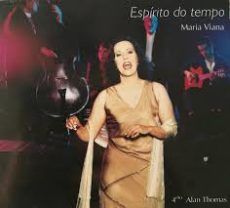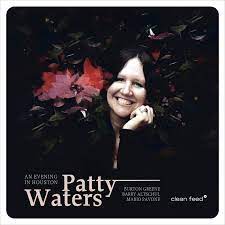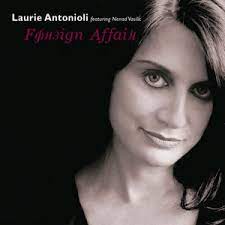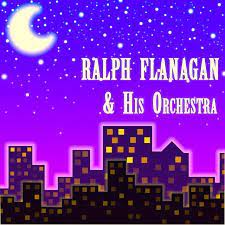
Daily Dose Of Jazz…
Maria Viana was born on March 17, 1958, Lisbon, Portugal and was the daughter of famous actor and painter, José Viana; and Brazilian singer and actress Jujú Baptista. A meeting with jazz critic and missionary José Carlos Monteiro Costa introduced her Ella Fitzgerald, Billie Holiday, Sarah Vaughan and Anita O’Day. He also introduced her to the producers of Cascais Jazz Festival, Luis Villas-Boas and Duarte Mendonça who took an immediate interest in her, arranging for rehearsals and jam sessions.
It was not until 1983 that she vigorsly pursued her professional ambitions in Jazz, because previously she had been an actress and a famous popsinger. She became the host-singer at the jazz bar, Drogaria Ideal, where dozens of soloists, amateurs and professionals performed. Within months Maria’s career progressed and revealed unquestionable talent and abilities.
She would go on to do television, festivals, record, and work with Al Grey, Bernardo Sasseti, and David Gausden. She created the Maria Viana Quintet, and toured the country for the National Secretary of Culture. 1995 Produces / features in concert, Around the World, Around the Forties, for the celebration of fifty years since the Second World War ending; an initiative of C.M. de Cascais. Tours Portugal with her quintet, and tours with Bill Goodwin quintet.
Maria’s work is rewarded with a Declaration of Manifest Cultural Value, has guested on several recordings and concerts, and became the Artistic Director for Hotels with Jazz. She produced Jazz na Casa da Guia, and Blues for Cascais, benefiting an ecological organization in Cascais.
Through the years vocalist Maria Viana has been featured on over sixty national television shows and concerts and continues to perform and tour.
More Posts: bandleader,history,instrumental,jazz,music,vocal

Daily Dose Of Jazz…
Patty Waters was born on March 11, 1946 in Iowa and started singing semi-professionally in high school. After school, she sang for the Jerry Gray Hotel Jazz Band, then her family moved to Denver, Colorado. There she started listening to Billie Holiday, whose life and singing had a profound influence on her.
The early 1960s saw her following the recommendation of friends to move to New York City. Albert Ayler heard her in a dining club and introduced her to Bernard Stollman, the owner of the experimental jazz label ESP-Disk. Her most influential albums, Sings released in 1965) and College Tour in 1966 were recorded on this label.
In the late 1960s, she spent time in Europe and then left the music world in 1969 to raise her son in California. Almost 30 years later she recorded the album Love Songs in 1996 and began performing in public again. In 2004 she released You Thrill Me: A Musical Odyssey, a collection of rare and unissued recordings from the years 1962–1979.
She returned in 2019 with the album Live recorded at the First Unitarian Congregational Church in Brooklyn. The album was followed in 2020 by another live recording entitled An Evening In Houston. That same year she released an unissued 1970 LP titled Plays via her own label.
Vocalist Patty Waters, best known for her free jazz recordings in the Sixties and her recording of the nearly fourteen minute version of the traditional song Black Is the Colour (Of My True Love’s Hair from Sings, which is rendered in a haunting, anguished wail, continues to record, perform and tour.
More Posts: bandleader,history,instrumental,jazz,music,vocal

Daily Dose Of Jazz…
Laurie Antonioli was born on March 9, 1958 in Marin County. California. At the age of sixteen she began playing guitar and performing primarily her own original music as well as that of the singer-songwriters of the era. In 1975 she won the American Songwriters Contest for high school students, studied jazz at Mt. Hood Community College in Gresham, Oregon and Cal State Long Beach. She took private lessons from Mark Murphy and Joe Henderson.
After graduation, Laurie continued composing and performing. In 1980 she toured Europe for eight months with New Orleans saxophonist Pony Poindexter. When he suffered a stroke, a record date in Paris with pianist Kenny Drew was canceled and they were unable to finish out their tour. Laurie brought Pony back to California where she lived and led her own bands based out of San Francisco.
1985 saw Antonioli signing with Catero Records and her first album was the live two-track Soul Eyes, with the title song given to her by composer Mal Waldron. She was accompanied by pianist George Cables. After a hiatus from music, she settled in Vienna, Austria from 2002 to 2006 and began recording again.
Her Nabel Records album Foreign Affair was a Balkan jazz hybrid recorded in Slovenia with musicians from Serbia, Albania, Germany, and the U.S. It was well received in Europe. Her next album The Duo Session enlisted Richie Beirach where she wrote lyrics to his compositions. Laurie also wrote lyrics to some Miles Davis tunes and free improvisation pieces. This recording was also well-received but like Foreign Affair was known primarily to European audiences.
As an educator she held the position of Professor of the Vocal Department at KUG University’s Jazz Institute in Graz, Austria from 2002 to 2006 while living and performing in Europe. Antonioli was offered a position at the California Jazz Conservatory in Berkeley, California as the school’s vocal program director and created an eight-semester vocal performance curriculum. Singer and record producer Laurie Antonioli, who between 1985 and 2018 she has recorded seven albums, continues to perform and record.
More Posts: educator,history,instrumental,jazz,lyricist,music,vocal

Daily Dose Of Jazz…
Herb Bushler was born on March 7, 1939 in New York City and played piano and tuba in his youth before picking up double bass. Classically trained in bass he has performed with symphony orchestras in this capacity.
In 1966 he began a longtime association with ballet and film composer Coleridge-Taylor Perkinson. Herb played with The Fifth Dimension in the 1960s. He worked extensively in jazz idioms in the 1960s and 1970s, including with David Amram, Ted Curson, Blossom Dearie, Tony Williams, and Paul Winter.
He first played with Gil Evans in 1967 and the association would continue on and off until 1981. During the 1970s Bushler recorded sessions with Enrico Rava, Joe Farrell, Ryo Kawasaki, David Sanborn and Harold Vick. He also worked with Dee Dee Bridgewater, Billy Harper, Les McCann, Enrico Rava, Joe Chambers, and Howard Johnson.
Bassist Herb Bushler, whose composition Herbs was recorded by David Sanborn, at 85 years old continues to occasionally play both double bass and electric bass.

Daily Dose Of Jazz…
Harry Charles Prime was born on March 5, 1920 in Philadelphia, Pennsylvania. He graduated from St. Bridget’s Elementary and Roman Catholic High School. In the fall of 1944, he entered and won a singing contest at the 400 Club in Washington, D.C. and was offered a week’s engagement at the Club.
From there he proceeded to perform with big bands such as Randy Brooks, Tommy Dorsey, Jack Fina and Ralph Flanagan throughout the 1940’s and 50’s. Prime’s recording of the song Until with Tommy Dorsey sold a million records, but recording most of his hit songs with the Flanagan band.recording most of his hit songs with the latter.
In 1945, the Nations Disc Jockeys voted the Ralph Flanagan Band as the #1 band in the country and Prime was voted 20th best singer ahead of Dennis Day, Eddie Fisher and Dean Martin.
In the years following his tenure with the big bands, Prime never strayed far from the music business and worked as a disc jockey and radio host in various cities including WCAU in Philadelphia and WNPV in Lansdale.
His impeccable phrasing and vocal prowess led him to record Dear Hearts and Gentle People, Oh, What a Beautiful Morning, Nevertheless and Just One More Chance. He sits among the likes of Bob Eberle, Billy Eckstine, Dick Haymes, Frank Sinatra and Perry Como.
Prime recorded nearly 100 songs in the 1940s and 1950s, including Until, a million-seller with the Tommy Dorsey Orchestra. The song peaked at number four in the US chart.
Big band vocalist Harry Prime died on June 15, 2017 in Chalfont, Pennsylvania at age 97.
More Posts: history,instrumental,jazz,music,vocal


